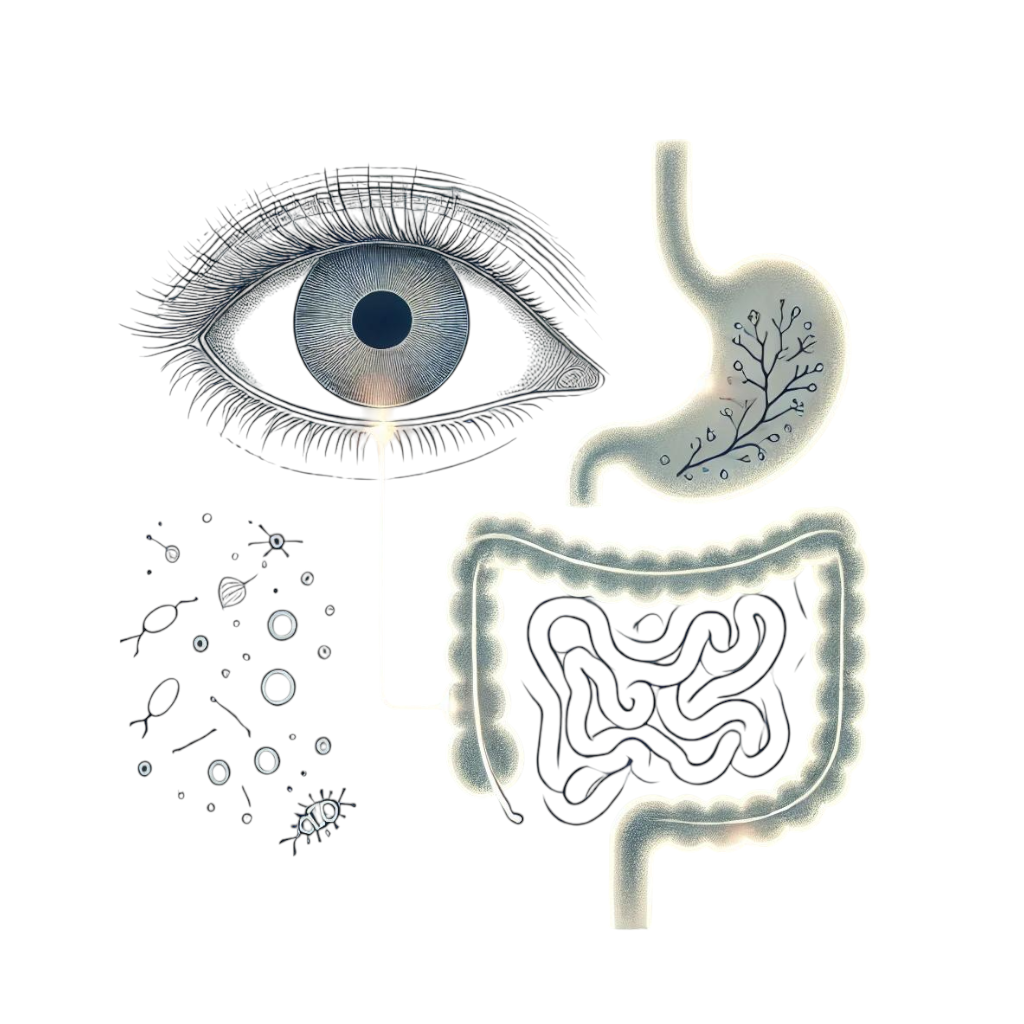Depression, Anxiety, and Psychological Disorders in Individuals with Vision Loss: A Focus on Age-Related Macular Degeneration
Abstract
Vision loss, particularly due to age-related macular degeneration (AMD), is strongly associated with increased rates of depression, anxiety, and psychological distress. The emotional impact of losing vision can significantly reduce quality of life, exacerbate social isolation, and contribute to cognitive decline. This review explores the prevalence, risk factors, pathophysiological mechanisms, and management strategies for psychological disorders in individuals with AMD. It highlights recent findings on the relationship between AMD and mental health, emphasizing the role of stress, neuroplasticity, and coping mechanisms. Furthermore, advancements in digital mental health interventions, artificial intelligence (AI), and multidisciplinary approaches to care are discussed as potential solutions for improving psychological outcomes in AMD patients.
1. Introduction
Age-related macular degeneration (AMD) is a leading cause of irreversible vision loss, affecting millions worldwide. Beyond its impact on visual acuity, AMD significantly influences mental health, leading to a higher prevalence of depression, anxiety, and psychological distress compared to the general population [1,2]. Studies indicate that up to 39% of individuals with AMD experience clinically significant depressive symptoms, largely due to the profound disruption of daily activities, loss of independence, and reduced social engagement [3].
Although psychological disorders in vision loss are well recognized, they remain underdiagnosed and undertreated in AMD patients [4]. This review examines the complex interplay between vision loss and mental health, exploring neurobiological mechanisms, psychosocial impacts, and emerging interventions aimed at improving mental well-being in individuals with AMD.
2. Prevalence and Risk Factors of Psychological Disorders in AMD
2.1 Prevalence of Depression and Anxiety in AMD Patients
Numerous epidemiological studies highlight that AMD patients are at a two to four times higher risk of developing depression and anxiety disorders than the general population [5,6]. The chronic, progressive nature of AMDcontributes to persistent stress, leading to the emergence of mood disorders.
- Depression rates in AMD range from 15% to 39%, depending on the severity of vision loss and accessibility to support systems [7].
- Anxiety disorders, including generalized anxiety disorder and panic disorder, are common due to fear of complete blindness [8].
- Suicidal ideation has been reported in severe AMD cases, emphasizing the need for early psychological intervention [9].
2.2 Key Risk Factors
Several biological, psychological, and social factors contribute to psychological distress in AMD patients:
- Extent of Vision Loss: Patients with bilateral AMD face higher rates of depression than those with unilateral involvement [10].
- Social Isolation: Reduced mobility and difficulty recognizing faces contribute to loneliness and social withdrawal [11].
- Cognitive Dysfunction: Studies show that cognitive impairment is more prevalent in AMD patients, potentially exacerbating mood disorders [12].
- Comorbid Medical Conditions: AMD is often associated with other chronic diseases (e.g., diabetes, cardiovascular disease) that further elevate mental health risks [13].
3. Pathophysiology of Depression and Anxiety in AMD
3.1 Neurobiological Mechanisms
Neuroimaging studies indicate that vision loss triggers compensatory changes in brain function, particularly in the visual cortex and limbic system, regions associated with mood regulation [14]. Key findings include:
- Increased amygdala activity, contributing to heightened emotional responses and anxiety [15].
- Reduced serotonergic function, linked to depressive symptoms in AMD patients [16].
- Cortical reorganization, where the brain adapts to vision loss but may inadvertently heighten psychological distress [17].
3.2 The Role of Stress and Inflammation
Chronic stress due to progressive vision loss leads to dysregulation of the hypothalamic-pituitary-adrenal (HPA) axis, resulting in elevated cortisol levels and chronic low-grade inflammation, both of which are strongly associated with depression [18]. Increased oxidative stress in AMD may also contribute to neuronal dysfunction, exacerbating both visual and emotional impairments [19].
4. Management Strategies
4.1 Psychological and Behavioral Interventions
Cognitive-behavioral therapy (CBT) and mindfulness-based stress reduction (MBSR) have been shown to significantly alleviate depressive and anxiety symptoms in individuals with AMD [20,21]. Other key interventions include:
- Support groups and peer counseling, which enhance emotional resilience [22].
- Vision rehabilitation programs, helping individuals regain functional independence and confidence [23].
- Telemedicine-based mental health support, providing accessible therapy options for AMD patients [24].
4.2 Pharmacological Approaches
Selective serotonin reuptake inhibitors (SSRIs) and serotonin-norepinephrine reuptake inhibitors (SNRIs) are commonly used to treat depression in AMD patients, with some evidence supporting their efficacy in improving quality of life [25]. However, clinicians should monitor for drug interactions and side effects in elderly AMD populations [26].
4.3 Emerging AI and Digital Health Interventions
Artificial intelligence (AI)-based mental health screening tools are increasingly being explored to detect early signs of depression and anxiety in AMD patients. Machine learning models can analyze speech patterns, facial expressions, and digital biomarkers to provide early psychological risk assessments [27]. Additionally, AI-powered chatbotsand virtual reality therapy are being developed to support mental health care for visually impaired individuals [28].
5. Future Directions and Conclusion
While significant progress has been made in recognizing and managing psychological disorders in AMD, more research is needed to refine treatment approaches, integrate AI solutions, and develop tailored mental health interventions. Healthcare providers should adopt a multidisciplinary approach combining ophthalmology, psychiatry, rehabilitation, and digital health solutions to ensure holistic patient care.
Addressing depression, anxiety, and stress in AMD is essential to improving quality of life, reducing disability, and enhancing patient well-being. Future studies should focus on personalized interventions, leveraging digital technology to support the mental health of individuals affected by vision loss.
References
1. https://jamanetwork.com/journals/jamaophthalmology/fullarticle/2780413
2. https://www.wjgnet.com/2220-3206/full/v14/i3/362.htm
3. https://pmc.ncbi.nlm.nih.gov/articles/PMC5324400/
4. https://pmc.ncbi.nlm.nih.gov/articles/PMC5903583/
5. https://pmc.ncbi.nlm.nih.gov/articles/PMC10300666/
6. https://pmc.ncbi.nlm.nih.gov/articles/PMC8547669/
7. https://www.frontiersin.org/journals/aging-neuroscience/articles/10.3389/fnagi.2023.1247413/full
8. https://journals.plos.org/plosone/article?id=10.1371/journal.pone.0125394
9. https://pmc.ncbi.nlm.nih.gov/articles/PMC4416755/
10. https://bmcpublichealth.biomedcentral.com/articles/10.1186/s12889-020-09255-7
11. https://www.nature.com/articles/s41598-024-52389-6
12. https://pmc.ncbi.nlm.nih.gov/articles/PMC10821922/
13. https://pmc.ncbi.nlm.nih.gov/articles/PMC11242547/
14. https://pmc.ncbi.nlm.nih.gov/articles/PMC10397192/
15. https://pmc.ncbi.nlm.nih.gov/articles/PMC8953773/
16. https://pmc.ncbi.nlm.nih.gov/articles/PMC10534048/
17. https://pmc.ncbi.nlm.nih.gov/articles/PMC8625187/
18. https://pmc.ncbi.nlm.nih.gov/articles/PMC9819966/
19. https://pmc.ncbi.nlm.nih.gov/articles/PMC9380024/
20. https://pmc.ncbi.nlm.nih.gov/articles/PMC8904792/
21. https://pmc.ncbi.nlm.nih.gov/articles/PMC8414246/
22. https://pmc.ncbi.nlm.nih.gov/articles/PMC6439709/
23. https://pmc.ncbi.nlm.nih.gov/articles/PMC9458640/pdf/41598_2022_Article_19429.pdf
24. https://pmc.ncbi.nlm.nih.gov/articles/PMC9458640/
25. https://pmc.ncbi.nlm.nih.gov/articles/PMC5866182/
26. https://pmc.ncbi.nlm.nih.gov/articles/PMC2612975/
27. https://pmc.ncbi.nlm.nih.gov/articles/PMC5168634/
28. https://pmc.ncbi.nlm.nih.gov/articles/PMC2792986/
29. https://pmc.ncbi.nlm.nih.gov/articles/PMC7075932/pdf/41598_2020_Article_61706.pdf
30. https://pmc.ncbi.nlm.nih.gov/articles/PMC3591459/
31. https://www.researchgate.net/publication/365282928_Psychological_Impact_of_Vision_Loss
32. https://www.nature.com/articles/s41598-020-61706-8
33. https://pmc.ncbi.nlm.nih.gov/articles/PMC9458640/ß
34. https://pubmed.ncbi.nlm.nih.gov/27913556/
35. https://canadianeyecaretoday.com/article/view/1-3-1
36. https://www.frontiersin.org/journals/aging-neuroscience/articles/10.3389/fnagi.2013.00056/full
37. https://pmc.ncbi.nlm.nih.gov/articles/PMC11172702/
38. https://pmc.ncbi.nlm.nih.gov/articles/PMC5636717/
39. https://pubmed.ncbi.nlm.nih.gov/36717001/
40. https://pmc.ncbi.nlm.nih.gov/articles/PMC6086446/
41. https://pmc.ncbi.nlm.nih.gov/articles/PMC6086446/
42. https://www.nature.com/articles/s41598-021-04167-x
43. https://pmc.ncbi.nlm.nih.gov/articles/PMC5388862/#:


Leave a comment
This site is protected by hCaptcha and the hCaptcha Privacy Policy and Terms of Service apply.